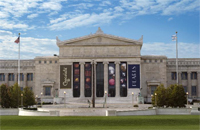
Field Museum of Natural History, Chicago

Botany Department
1400 South Lake Shore Drive
Chicago, IL 60605-2496
United States
Christine Niezgoda, Collections Manager
Email: cniezgoda@fieldmusuem.org
The Department of Botany at the Field Museum houses over 2.3 million flowering plants which ranks the Field Museum herbarium fifth in the U.S. This number includes approximately 37,000 type specimens, with strong representation of neotropical taxa. Especially rich are holdings in the neotropical families Rubiaceae, Asteraceae, Palmae, Piperaceae, and Solanaceae. The Museum's Central American collection is overall one of the world's finest single collections with special strengths in Guatemala, Honduras, and Costa Rica. The South American collections are important with special strengths in Venezuela, Colombia, Ecuador, and Peru. A good representation in North American taxa is found, especially for Missouri and Illinois, and unmarked types are frequently discovered in these holdings.
Past and present staff have contributed greatly to the growth of the collections, including the following:
- Jesse H. Greenman collected extensively in Mexico and Central America from 1904-1912.
- B. E. Dahlgren concentrated on collecting palms in Cuba, Brazil and British Guiana, his most active field work being conducted between 1909 and 1938.
- J. Francis Macbride initiated the Flora of Peru project in 1922, and added significantly to the Peruvian holdings through his own expeditions and through attracting collections of others. Specimens generated from this project provided the Field Museum with one of the world's best overall collections of Peruvian plants. In connection with the Flora of Peru , Macbride spent about ten years in Europe photographing type specimens of South American plants at major European botanical institutions. During this time he arranged for exchange of significant numbers of Latin American specimens, many of them unmarked types, from the herbaria in Vienna, Paris, Madrid, Geneva, Munich and Berlin. Many of these early collections, such as those of Ruiz and Pav��n, Blanchet, Glaziou, Pohl and Schott, are not well represented in other U.S. herbaria.
-
Paul C. Standley joined the staff in 1927 and began extensive fieldwork in Central America. Since Standely frequently did not make duplicates, many of his collections at the Field Museum are unique, at least within the United States herbaria. Among his many publications are The Flora of the Lancetilla Valley (Honduras) , The Flora of Costa Rica , The Rubiaceae of Colombia , also of Ecuador, of Bolivia, and of Venezuela.
In 1938 he began The Flora of Guatemala, which also attracted many new collections to the Museum. He was later joined in this project by Julian Steyermark, who made numerous valuable collections in Guatemala and contributed to the published flora.
- Julian Steyermark also completed the Flora of Missouri while at the Field Museum, and deposited his study specimens here. In the 1940's, Steyermark initiated collecting programs in Venezuela and Ecuador, and the Field Museum's holdings of these early collections are not duplicated elsewhere in North America.
- Louis O. Williams joined the staff in 1960, and supervised the completion of the Flora of Guatemala (13 parts and 6528 pages). Williams also collected widely in Central America, and developed an active research program that supported the work of other collectors, such as Antonio Molina of Honduras.
In recent years the botany department has collaborated on the Flora of Veracruz, Mexico project from 1973-1985 resulting in the herbarium housing the nation's best collection of plants from that area. During the 1980's South American representations increased due to the collecting efforts of Timothy Plowman whose expeditions included trips to Brazil, Colombia, Ecuador, Peru and Venezuela.
More recently floristic projects and collection oriented research programs have continued to build on the Museum's neotropical strengths, particularly in Central America with Williams Burger's Flora Costaricensis and Michael Dillon's coordination of the Asteraceae for the Flora of Nicaragua project. The collections of Michael Dillon have greatly improved our holdings from Peru and Chile as he continues floristic and monographic efforts in the Peruvian flora. His work on the Asteraceae over the past ten years has added numerous specimens to that family's holdings. Thomas Lammers provided monographic efforts for the Campanulaceae in Peru and Chile. Resident Research Associates maintain active programs that contribute to collection strength, including Robin Foster's inventory projects in Peru, Panama and Bolivia, and Doel Soejarto's drug plant exploration in Guatemala and the Paleotropics.
The herbarium also expanded through purchase of major private collections and through acquisition of herbaria of the University of Chicago, Northwestern University, Catholic University, and the University of Illinois at Chicago, among others.
